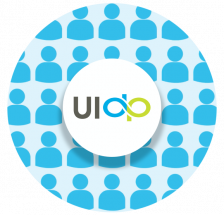New Member Spotlight: University of Massachusetts Amherst
 The University of Massachusetts Amherst invests more than $200 million a year in research and partners with industry across more than 60 research centers and institutes. Martina Nieswandt, associate vice chancellor for research and engagement, works to increase research support capacity and services, improving research communication and implementing strategic initiatives. She recently shared her insight about involvement with UIDP.
The University of Massachusetts Amherst invests more than $200 million a year in research and partners with industry across more than 60 research centers and institutes. Martina Nieswandt, associate vice chancellor for research and engagement, works to increase research support capacity and services, improving research communication and implementing strategic initiatives. She recently shared her insight about involvement with UIDP.
UIDP: What is the university hoping to gain from this membership with UIDP in the coming year?
Nieswandt: We are hoping our membership will allow us to learn best practice from other leaders in the field and share our own, including solutions that foster effective collaborations between university and industry partners. Furthermore, we are interested in UIDP’s networking opportunities with industry partners and other universities in order to identify new partners and collaborations leveraging our strategic strengths. Finally, we are eager to engage with UIDP’s training programs and webinars as well as attend UIDP’s conference to increase our knowledge and expertise in economic development.
UIDP: What are the current challenges that the University of Massachusetts Amherst is facing in the development of university-industry partnerships?
Nieswandt: UMass Amherst has a high number of engagements with industry partners (204 awards in 2020 for $10.7 million), which demonstrates that companies value our research expertise. However, we can grow further. One of our challenges is that some faculty do not imagine themselves working with industry partners. They are often focused mainly on federally-funded research, although their work has high potential for industry collaboration. Examples of successful partnerships and creating opportunities for our faculty to interact with industry partners from the UIDP network might make faculty more interested in exploring industry partnerships, encourage more “concept to commercialization innovations,” and in turn increase the number of such partnerships.
UIDP: Please share innovative ways that you are making an impact on U-I interactions.
Nieswandt : Nine years ago, UMass Amherst created the UMass Innovation Institute (UMII) under the oversight of the vice chancellor for research and engagement. UMII’s mission is to increase opportunities for research support and to facilitate more efficient and effective partnerships. UMII acts as a one-stop-shop for faculty and industry through its commitment to responsiveness, agility, flexibility, and timeliness in dealing with sponsors, collaborators, faculty, and external stakeholders. UMII enables UMass Amherst to expand the impact of its research in new directions, with new partners, and through creative approaches to collaboration. UMII has developed a number of strategic partnerships under master research agreements as well as master service agreements for use of core facilities.
A recent expansion to the UMass Amherst Mt. Ida Campus in Newton, nine miles west of Boston, offers the university (located 100 miles West of Boston) closer proximity to industry partners predominantly situated in the Eastern part of the state. We are offering co-working and dedicated office and lab space to companies interested in working with our faculty, provide students with professional experiences through internships and co-ops, and offer companies the ability to recruit our students as well as reskilling and retraining their staff through workforce development.
In 2019, UMass Amherst’s operations contributed $2.5 billion to the Massachusetts economy, seven times the state’s investment of $360 million.
UIDP: Tell us about a particularly successful U-I project or partnership.
Nieswandt: UMass Amherst created the Institute for Applied Life Sciences (IALS) in 2015 with funding from the Massachusetts Life Science Center. IALS is a 300,000 square foot collaborative workspace including 35 core facilities to translate fundamental research into innovative products, technologies, and services that deliver benefits to human health and well-being. Organized into three large centers (Center for Personalized Health Monitoring, the Center for Bioactive Delivery, and the Models to Medicine Center), IALS combines deep and interdisciplinary expertise of more than 200 faculty-led research groups from 29 UMass departments. Working closely with industry partners, IALS combines academic innovation with an industry-like focus on delivering commercially significant products, services, and technologies. IALS Core Facilities, available to both internal and external users, enable faculty, students, and industry collaborators to access a broad array of equipment to enhance their R&D capabilities, address both basic and translational questions, deliver technologies and product candidates more rapidly, and become more competitive in obtaining state, federal, foundation, and private funding.
IALS is designed to be product-focused, interdisciplinary, collaborative, outward-looking, and entrepreneurial. IALS COVID-19 Response Teams are an excellent example of this approach: A large and diverse group of scientists bringing together expertise from engineering, the life sciences, nursing, computer science, and public health and health sciences to address regional unmet needs, such as a lack of enough personal protective devices (PPDs), and a lack of specific reagents needed for COVID-19 testing (read more: https://www.umass.edu/ials/covid19).
UIDP: Please share something that you would like the UIDP community to know about your organization relevant to your external collaborations.
Nieswandt: UMass Amherst, founded in 1863 as a land-grant institution, is the flagship public university within the University of Massachusetts System, the largest public research university in New England and, unknown to many, located 100 miles west of Boston. Among Massachusetts colleges and universities, UMass Amherst ranks fourth in research grants from the National Science Foundation, behind only MIT, Harvard, and Boston University, and is the largest supplier of STEM graduates to the Massachusetts innovation economy


